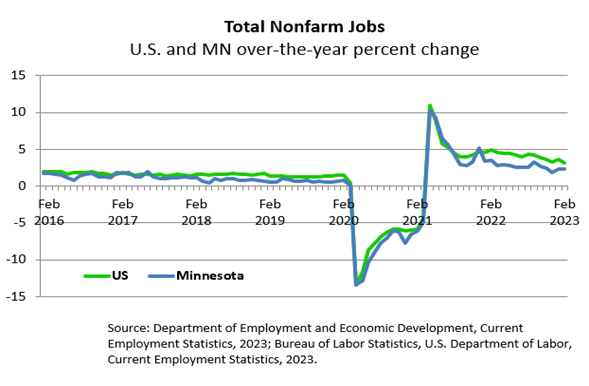by Nick Dobbins
March 2023
The Minneapolis-St. Paul-Bloomington MSA added 12,089 jobs (0.6%) over the month in February. Mining, Logging, and Construction employment in the metro was up by 3.5% (2,578 jobs), the largest proportional growth of any supersector in the area. The largest real job growth came in Educational and Health Services, which added 4,725 jobs (1.4%), with growth in both component sectors. Government employers added 4,552 jobs (1.9%) with positive growth at all three levels of government. Three supersectors lost jobs on the month, with the only large decline coming in Trade, Transportation, and Utilities, which was off by 4,363 (1.3%).
Over the year employment in the metro area was up by 35,327 or 1.9%. This was the lowest proportional growth of any MSA in Minnesota. Six of 10 published supersectors added jobs on the year with the largest real and proportional growth coming in Leisure and Hospitality (up 16,667 or 10.4%). Educational and Health Services added 9,622 jobs (2.8%). All of that growth came in Health Care and Social Assistance (up 12,487 or 4.3%), as Educational Services lost 2,865 jobs or 5.9%. Manufacturing employers added 6,627 jobs or 3.3%. The largest declines came in Professional and Business Services (down 3,676 or 1.2%) and Financial Activities (down 2,804 jobs or 1.9%).
The Duluth area added 1,158 jobs or 0.9% in February. This was the highest proportional growth of any MSA primarily in Minnesota. Fargo-Moorhead, which is primarily in North Dakota, was up 1.1%. Government employers led the growth, adding 721 jobs, or 3%. Mining, Logging, and Construction was up 168 or 1.8%, and Other Services was up 61 jobs or 1.1%. Three supersectors posted negative growth, but the largest real job loss among them was seven in both Financial Activities and Manufacturing.
Over the year the Duluth area added 2,260 jobs (1.8%). Mining, Logging, and Construction was up 5.6% (491 jobs). Trade, Transportation, and Utilities added 824 jobs (3.5%) as component Retail Trade added 747 jobs (5.2%). Leisure and Hospitality employment was up by 469 or 3.6%. Two supersectors lost jobs on the year. Government employers shed 137 jobs (0.5%), and Information employers shed 56 (5.6%).
The Rochester MSA added 658 jobs (0.5%) in February. Educational and Health Services added 476 jobs (0.9%), and Leisure and Hospitality added 137 (1.3%). Trade, Transportation, and Utilities had the largest real and proportional decline, off by 86 jobs or 0.5%, with losses in all three published components.
Over the year the Rochester area added 3,768 jobs or 3.2%. This was tied with Mankato-North Mankato for the highest proportional growth of any MSA primarily in Minnesota. Educational and Health Services added 1,268 jobs (2.4%), Leisure and Hospitality added 624 (6.3%), and Government added 517 (4.2%), with most of that growth coming at the Local Government level (up 471 or 4.7%). Trade, Transportation, and Utilities added 599 jobs (3.5%) with component Retail trade also up 599 (5%). Information was the only supersector to post negative growth, losing 44 jobs (4%).
The St Cloud MSA added 515 jobs (0.5%) over the month in February. This was the worst proportional growth of any MSA in the state, although the best was just 1.1% (Fargo-Moorhead), so the range was fairly narrow. Trade, Transportation, and Utilities posted the largest real and proportional decline, losing 137 jobs (0.6%) with losses in all three component sectors. Government employers had the largest real and proportional growth, adding 253 jobs or 1.7%.
Over the year the St. Cloud MSA added 2,710 jobs (2.6%). Mining, Logging, and Construction added 830 jobs or 13.5%, the largest real and proportional growth of any supersector in the area. Manufacturing added 720 jobs (4.9%), and Leisure and Hospitality added 421 (5.6%). The largest real and proportional decline came in Professional and Business Services, which was off by 356, or 4.5%.
The Mankato-North Mankato MSA added 430 jobs (0.7%) in February. Service providers added 510 jobs (1.1%) while goods producers lost 80 jobs (0.8%). Public sector employers added 278 jobs (2.8%), and private sector employers added 152 (0.3%).
Over the year the Mankato area added 1,786 jobs, or 3.2%. This was tied with Rochester for the best proportional growth of an MSA primarily in Minnesota. Goods producers added 401 jobs (4.1%), and service providers added 1,385 (3%).
The Fargo-Moorhead MSA added 1,590 jobs (1.1%) over the month of February. It was the largest proportional growth of any MSA in the state. Government employers added 916 jobs (4.7%), the largest real and proportional growth of any supersector in the MSA. State employers drove the growth, adding 645 jobs or 11.9%. Leisure and Hospitality was up 553 (4%). Manufacturing employers lost 136 jobs, or 1.2%.
Over the year the Fargo-Moorhead area added 4,337 jobs or 3%. Mining, Logging, and Construction added 1,001 jobs (13.2%), and Educational and Health Services added 1,373 jobs (5%). Two supersectors posted negative growth, with the largest real and proportional decline coming in Information, which was off by 233 or 8.1%.
The Grand Forks-East Grand Forks MSA added 523 jobs (1%) in February. Government employers added 234 jobs (1.8%), and Trade, Transportation, and Utilities added 137 jobs (1.3%) thanks to the addition of 172 jobs (2.6%) to Retail Trade. The largest real and proportional decline came in Manufacturing, which was off by 25 jobs or 0.6%.
Over the year employment in the Grand Forks-East Grand Forks MSA was up 3.8% or 1,963 jobs. This was the largest proportional growth of any MSA in Minnesota. Trade, Transportation, and Utilities was up 468 (4.6%). Retail Trade added 331 jobs (5%), and Wholesale Trade added 120 (7%). Government employers added 448 jobs (3.4%), with state employers added 176 jobs (3.1%) and local employers adding 275 (4.4%).
